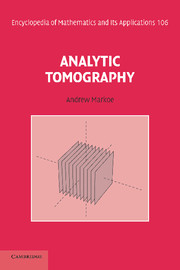Book contents
1 - Computerized Tomography, X-rays, and the Radon Transform
Published online by Cambridge University Press: 24 October 2009
Summary
Introduction
The purpose of this chapter is to give an informal introduction to the subject of tomography. There are very few mathematical requirements for this chapter, so readers who are not specialists in the field, indeed who are not mathematicians or scientists, should find this material accessible and interesting. Specialists will find a graphic and intuitive presentation of the Radon transform and its approximate inversion.
Tomography is concerned with solving problems such as the following. Suppose that we are given an object but can only see its surface. Could we determine the nature of the object without cutting it open? In 1917 an Austrian mathematician named Johann Radon showed that this could be done provided the total density of every line through the object were known. We can think of the density of an object at a specific point as the amount of material comprising the object at that point. The total density along a line is the sum of the individual densities or amounts of material.
In 1895 Wilhelm Roengten discovered x-rays, a property of which is their determining of the total density of an object along their line of travel. For this reason, mathematicians call the total density an x-ray projection. It is immaterial whether the x-ray projection was obtained via x-rays or by some other method; we still call the resulting total density an x-ray projection.
- Type
- Chapter
- Information
- Analytic Tomography , pp. 6 - 57Publisher: Cambridge University PressPrint publication year: 2006



